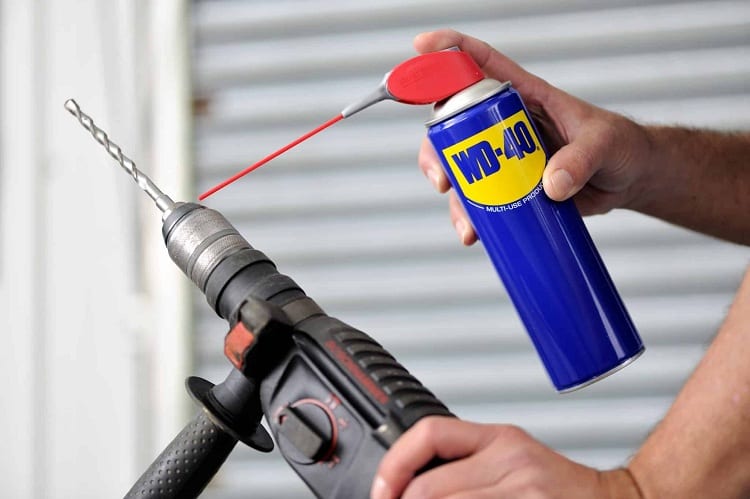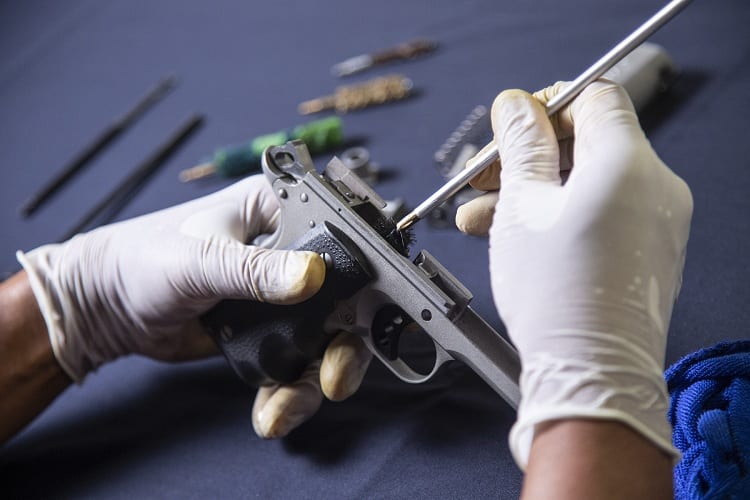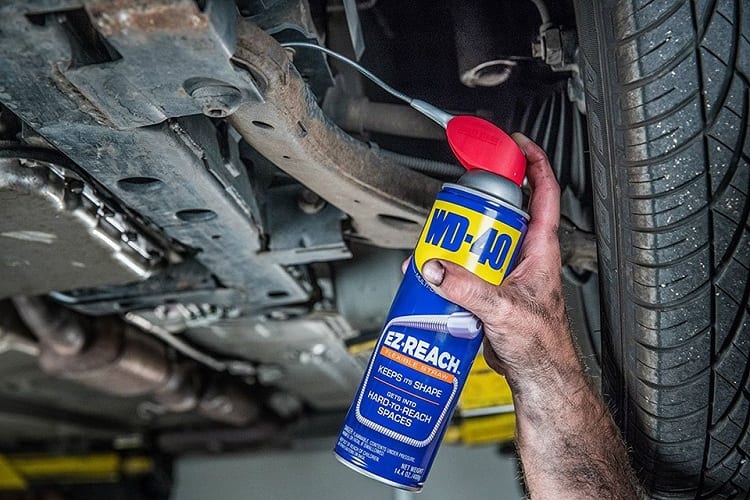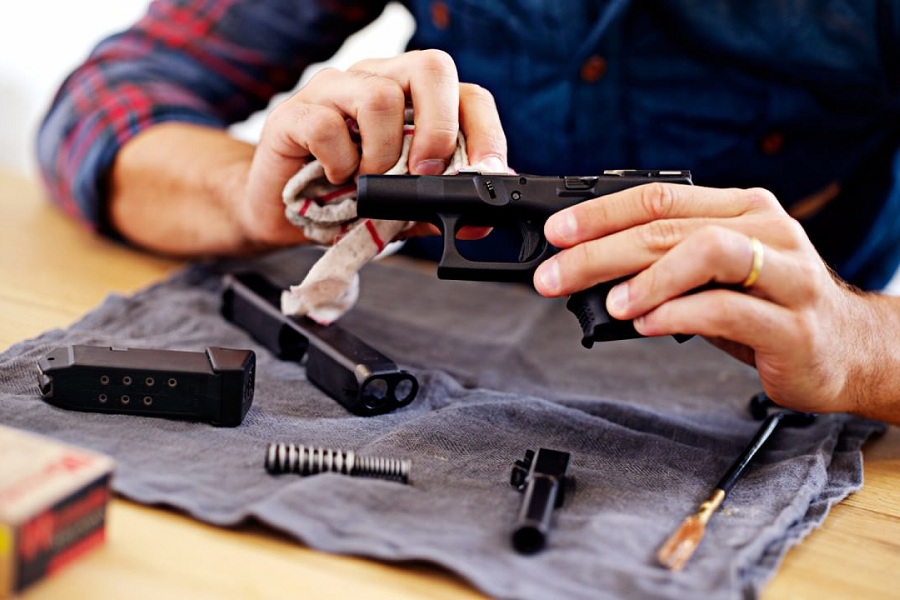When it comes to do-it-all solutions, WD-40 is considered a magical product, and there’s not much it can’t do.
When it comes to your guns though, this old-school method for keeping them clean has turned out to be not that helpful, and if you’re still using it on your firearms, you should probably stop.
Can you clean guns with WD-40? WD-40 isn’t recommended for cleaning firearms as it can get stuck in the crevices of the gun and cause the parts to jar or become gummy.
You should only ever use a cleaner or lubricant designed for firearms so that it keeps them in good condition.
If you’ve been a faithful user of WD-40 over the years, there’s no need to stop relying on it, but you should stop putting it anywhere near your firearms.
We’re going to answer all the pertinent questions about this multipurpose product and guide you towards some better ways to clean your gun.
Contents
What is WD-40?

WD-40 is a multi-purpose product designed for all kinds of indoor and outdoor use.
The ‘WD’ in its name stands for ‘water displacer’ and the 40 from the fact that it took 40 attempts for the manufacturer, Rocket Chemical Company, to get their now-famous yet secret formula right.
WD-40 gained public recognition in 1953 when it was used on the Atlas missile, and it became available commercially in 1958.
Today, WD-40 is used for just about anything you can think of including lubricating squeaky joints, removing water from crevices, dissolving rust and corrosion, and protecting metal from water.
As WD-40 is sprayed on, it’s wet, and over time, it evaporates, so the oily feeling you notice when you first apply it doesn’t stick around.
While it does work on a huge range of materials, when it comes to cleaning a firearm with it, most experts would advise against it.
Can You Use WD-40 on Guns?
WD-40 has been around for over 65 years, and for just as long as it’s been on the market, there have been faithful users who clean their guns with it.
However, even though it has all of the properties you’d want from a gun cleaner, you should never apply it to any part of your firearm.
The issue with WD-40 is not the way that it goes on, but what happens to it after the fact.
When you first spray it, the oil-based solvent seems harmless, but once it evaporates, there’s nothing left, and your gun will be exposed to rust, corrosion, dirt, and debris, just as it was before.
Unless you then follow it up with a coating of oil, you may as well not have sprayed any WD-40 on at all.
Secondly, as an aerosol solvent, the act of spraying WD-40 onto your gun is doing it harm as well.
While it seems like you’re spraying away debris and fouling, you’re just pushing it further into the smaller crevices of the firearm where it can’t be cleaned, which will cause the parts to feel gummy and start to stick.
While there are minor benefits to using WD-40 on a firearm like preventing a small amount of rust from forming and dissolving some of the fouling on it, it must be wiped away and followed up with another product.
However, when you weigh up these advantages, other products do a better job with less effort, so it’s time to stop relying on the solvent where your firearms are concerned.
The Best Products for Cleaning Your Gun

Responsible ownership of a firearm isn’t just about how you use and store your gun, but it includes keeping it clean and properly maintained as well.
For the best results, this means investing in a gun cleaning product that’s made for this specific purpose, however, there’s a lot to consider when choosing the right one
- Think about the type of firearm you have and stick to a cleaner made specifically for that. A shotgun, for example, has trickier parts that products can get stuck in and wooden stocks that you need to be cautious of.
- Avoid any multipurpose oils that claim to be okay for use on everything from bike chains to firearms. These have a high slip coefficient and they’re not recommended to go anywhere near guns.
- If you want a two in one product, choose something that has both a solvent and oil in it. This means the solvent will clean the gun first but leave the oil behind to protect it, which is exactly what your gun needs.
- This isn’t a product to skimp on, so don’t be afraid to spend a little extra to get something that will keep your gun in good condition for longer.
- Along with a good cleaner or oil, you’ll want to keep some other essentials on hand. A gun cleaning kit should also include mops for gauges, cotton cleaning patches, hemostats, a rubber cleaning mat, and some dental picks.
Situations When WD40 is Best

Although WD-40 isn’t recommended for cleaning firearms, there’s a whole host of ways you can use it for amazing results.
Many preppers keep a can of the solvent close by or in their survival kit because of its reputation of being a ‘toolbox in a can’, so consider some of these uses.
- Removing moisture: During a survival situation, the threat of rain, water, and moisture is a big one. If any of your kit’s components get water damage or have moisture where they shouldn’t, the very nature of WD-40 as a water disperser will be able to help.
- Removing rust: Rust can build up on your most prized survival kit contents and a quick spray of WD-40 will remove it. Not only does it work at getting the rust and corrosion off, but it can prevent it from building up in the future as well. Even if you plan on leaving things untouched for many years, WD-40 will keep them in good condition.
- Lubricating: Keeping a can of WD-40 close by means none of your important vehicles or devices will become stuck. The lubricating effect that the solvent has makes it perfect for spraying on any moving part including power tools, latches and hinges, and vehicles. If you need to get somewhere in a hurry, you’ll be grateful you have the solvent in a can.
- Vehicle protection: During a survival situation in the dead of winter, there’s a good chance your car will encounter some problems. WD-40 can be used to spray down various parts of the vehicle so they don’t freeze over or get encased in ice, and it has other uses like drying ignition wires, removing residue from solenoids, and stops window wipers and antennas from freezing.
- Cleaning parts: If you have various nuts, bolts, and screws that you use for different things, your WD-40 can is the easiest way to clean them. In an emergency situation, you’ll need a solvent to get a part clean and working again, so your can will come in handy.
Clean Your Guns With Care
When it comes to something as important and potentially dangerous as a firearm, you want to take every possible precaution while cleaning it.
Although WD-40 has hundreds of uses around the home and at work, you should leave a gun-specific cleaning agent to do the job of keeping your firearms in order.
Related Questions
WD-40 has been around for many years and most people have a can of it ready for action at home or their workplace.
This multipurpose solvent can do just about anything, and if you still have questions about where and how to use it, we’ve answered some of the more commonly asked ones.
Can WD-40 Clean Your Toilet?
WD-40 has become a popular method for cleaning toilets that are heavily stained because it breaks down rust and lime deposits.
The aerosol can be sprayed onto problem areas and left for a few minutes before being wiped away, and then your regular toilet cleaner and brush can be used.
What Should You Not Use WD-40 On?
Although touted as a multipurpose product, there are some things you should avoid spraying WD-40 on.
To avoid damage or sticking, keep WD-40 away from electronics, paintball guns and other similar weapons, bike chains, locks, and anything that has small crevices that are hard to reach.
Is WD-40 Dangerous?
WD-40 should always be used in a controlled environment with care taken to follow the manufacturer’s instructions for proper use.
If WD-40 is inhaled, the mist from the solvent can irritate the throat and lungs, and higher concentrations with extended use can do damage to the respiratory system and central nervous system.
Resources:


